DEP to UAM Vehicle Essay: System Architecture Development
VerifiedAdded on 2022/09/14
|10
|1878
|36
Essay
AI Summary
This essay delves into the systematic progression from Distributed Electric Propulsion (DEP) technology to Urban Air Mobility (UAM) vehicles. It emphasizes the application of technology development, system engineering, and system of systems engineering principles. The paper outlines a holistic design approach, incorporating modeling, abstraction, SysML, and cyber-physical modeling and simulation techniques. The essay explores the evolution of DEP-enabled concepts, design, and architecture of UAM aircraft, including feasibility, performance prediction, and operational concepts. It also discusses the development of assessment tools, noise reduction strategies, and methods for ride quality and gust load alleviation. The UAM vehicle's integration with existing transportation systems and operational modes is also considered. The essay highlights the significance of these elements in creating a faster, safer, cleaner, and integrated transportation system, addressing the challenges of urbanization and traffic congestion.

Running head: - DEP TO UAM VEHICLES
DEP TO UAM VEHICLES
Name of the Student
Name of the University
Author Note
DEP TO UAM VEHICLES
Name of the Student
Name of the University
Author Note
Paraphrase This Document
Need a fresh take? Get an instant paraphrase of this document with our AI Paraphraser

1DEP TO UAM VEHICLES
Table of Contents
1. DEP to UAM vehicle transmission:.......................................................................................2
2. References:.............................................................................................................................8
Table of Contents
1. DEP to UAM vehicle transmission:.......................................................................................2
2. References:.............................................................................................................................8
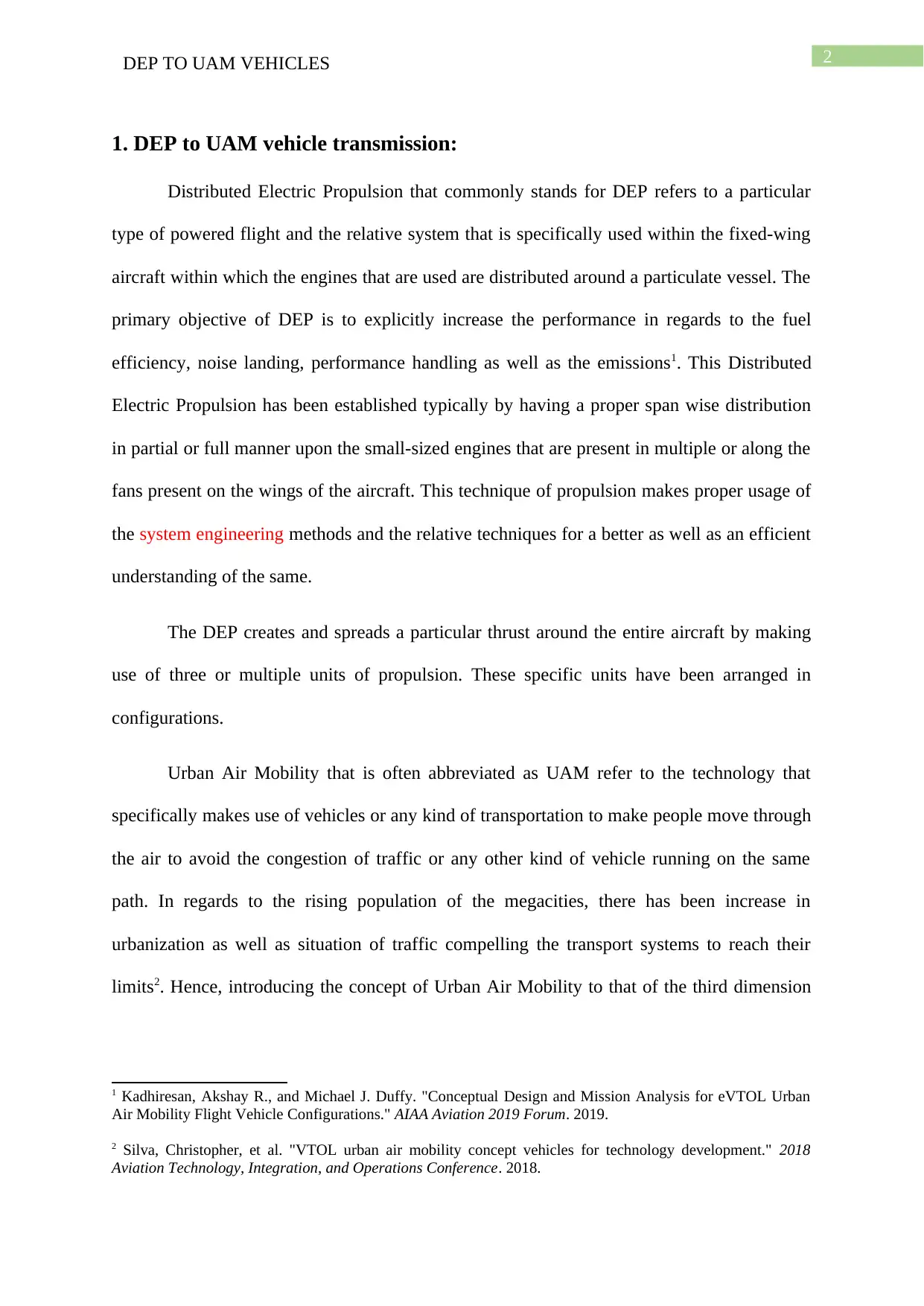
2DEP TO UAM VEHICLES
1. DEP to UAM vehicle transmission:
Distributed Electric Propulsion that commonly stands for DEP refers to a particular
type of powered flight and the relative system that is specifically used within the fixed-wing
aircraft within which the engines that are used are distributed around a particulate vessel. The
primary objective of DEP is to explicitly increase the performance in regards to the fuel
efficiency, noise landing, performance handling as well as the emissions1. This Distributed
Electric Propulsion has been established typically by having a proper span wise distribution
in partial or full manner upon the small-sized engines that are present in multiple or along the
fans present on the wings of the aircraft. This technique of propulsion makes proper usage of
the system engineering methods and the relative techniques for a better as well as an efficient
understanding of the same.
The DEP creates and spreads a particular thrust around the entire aircraft by making
use of three or multiple units of propulsion. These specific units have been arranged in
configurations.
Urban Air Mobility that is often abbreviated as UAM refer to the technology that
specifically makes use of vehicles or any kind of transportation to make people move through
the air to avoid the congestion of traffic or any other kind of vehicle running on the same
path. In regards to the rising population of the megacities, there has been increase in
urbanization as well as situation of traffic compelling the transport systems to reach their
limits2. Hence, introducing the concept of Urban Air Mobility to that of the third dimension
1 Kadhiresan, Akshay R., and Michael J. Duffy. "Conceptual Design and Mission Analysis for eVTOL Urban
Air Mobility Flight Vehicle Configurations." AIAA Aviation 2019 Forum. 2019.
2 Silva, Christopher, et al. "VTOL urban air mobility concept vehicles for technology development." 2018
Aviation Technology, Integration, and Operations Conference. 2018.
1. DEP to UAM vehicle transmission:
Distributed Electric Propulsion that commonly stands for DEP refers to a particular
type of powered flight and the relative system that is specifically used within the fixed-wing
aircraft within which the engines that are used are distributed around a particulate vessel. The
primary objective of DEP is to explicitly increase the performance in regards to the fuel
efficiency, noise landing, performance handling as well as the emissions1. This Distributed
Electric Propulsion has been established typically by having a proper span wise distribution
in partial or full manner upon the small-sized engines that are present in multiple or along the
fans present on the wings of the aircraft. This technique of propulsion makes proper usage of
the system engineering methods and the relative techniques for a better as well as an efficient
understanding of the same.
The DEP creates and spreads a particular thrust around the entire aircraft by making
use of three or multiple units of propulsion. These specific units have been arranged in
configurations.
Urban Air Mobility that is often abbreviated as UAM refer to the technology that
specifically makes use of vehicles or any kind of transportation to make people move through
the air to avoid the congestion of traffic or any other kind of vehicle running on the same
path. In regards to the rising population of the megacities, there has been increase in
urbanization as well as situation of traffic compelling the transport systems to reach their
limits2. Hence, introducing the concept of Urban Air Mobility to that of the third dimension
1 Kadhiresan, Akshay R., and Michael J. Duffy. "Conceptual Design and Mission Analysis for eVTOL Urban
Air Mobility Flight Vehicle Configurations." AIAA Aviation 2019 Forum. 2019.
2 Silva, Christopher, et al. "VTOL urban air mobility concept vehicles for technology development." 2018
Aviation Technology, Integration, and Operations Conference. 2018.
⊘ This is a preview!⊘
Do you want full access?
Subscribe today to unlock all pages.

Trusted by 1+ million students worldwide
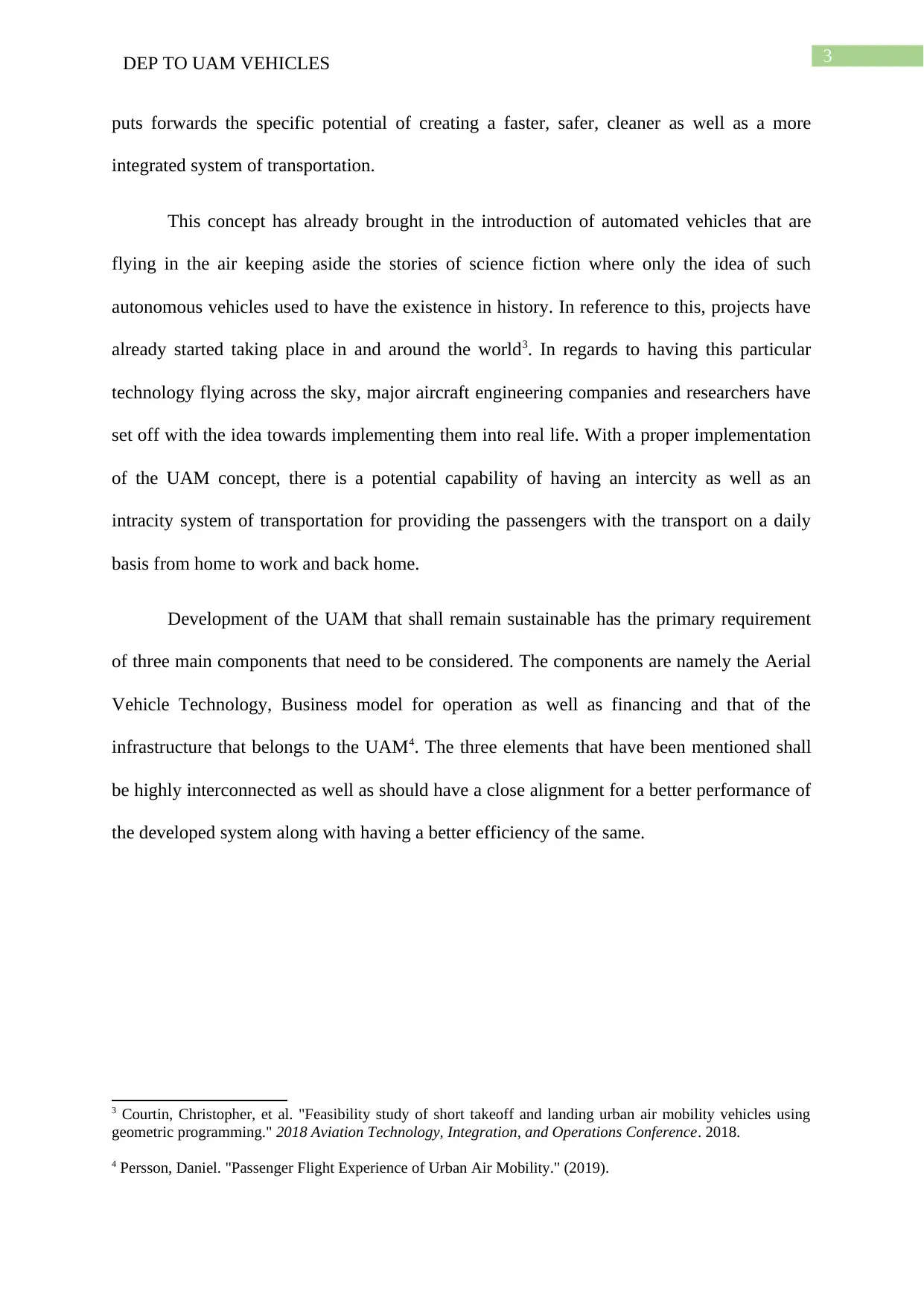
3DEP TO UAM VEHICLES
puts forwards the specific potential of creating a faster, safer, cleaner as well as a more
integrated system of transportation.
This concept has already brought in the introduction of automated vehicles that are
flying in the air keeping aside the stories of science fiction where only the idea of such
autonomous vehicles used to have the existence in history. In reference to this, projects have
already started taking place in and around the world3. In regards to having this particular
technology flying across the sky, major aircraft engineering companies and researchers have
set off with the idea towards implementing them into real life. With a proper implementation
of the UAM concept, there is a potential capability of having an intercity as well as an
intracity system of transportation for providing the passengers with the transport on a daily
basis from home to work and back home.
Development of the UAM that shall remain sustainable has the primary requirement
of three main components that need to be considered. The components are namely the Aerial
Vehicle Technology, Business model for operation as well as financing and that of the
infrastructure that belongs to the UAM4. The three elements that have been mentioned shall
be highly interconnected as well as should have a close alignment for a better performance of
the developed system along with having a better efficiency of the same.
3 Courtin, Christopher, et al. "Feasibility study of short takeoff and landing urban air mobility vehicles using
geometric programming." 2018 Aviation Technology, Integration, and Operations Conference. 2018.
4 Persson, Daniel. "Passenger Flight Experience of Urban Air Mobility." (2019).
puts forwards the specific potential of creating a faster, safer, cleaner as well as a more
integrated system of transportation.
This concept has already brought in the introduction of automated vehicles that are
flying in the air keeping aside the stories of science fiction where only the idea of such
autonomous vehicles used to have the existence in history. In reference to this, projects have
already started taking place in and around the world3. In regards to having this particular
technology flying across the sky, major aircraft engineering companies and researchers have
set off with the idea towards implementing them into real life. With a proper implementation
of the UAM concept, there is a potential capability of having an intercity as well as an
intracity system of transportation for providing the passengers with the transport on a daily
basis from home to work and back home.
Development of the UAM that shall remain sustainable has the primary requirement
of three main components that need to be considered. The components are namely the Aerial
Vehicle Technology, Business model for operation as well as financing and that of the
infrastructure that belongs to the UAM4. The three elements that have been mentioned shall
be highly interconnected as well as should have a close alignment for a better performance of
the developed system along with having a better efficiency of the same.
3 Courtin, Christopher, et al. "Feasibility study of short takeoff and landing urban air mobility vehicles using
geometric programming." 2018 Aviation Technology, Integration, and Operations Conference. 2018.
4 Persson, Daniel. "Passenger Flight Experience of Urban Air Mobility." (2019).
Paraphrase This Document
Need a fresh take? Get an instant paraphrase of this document with our AI Paraphraser
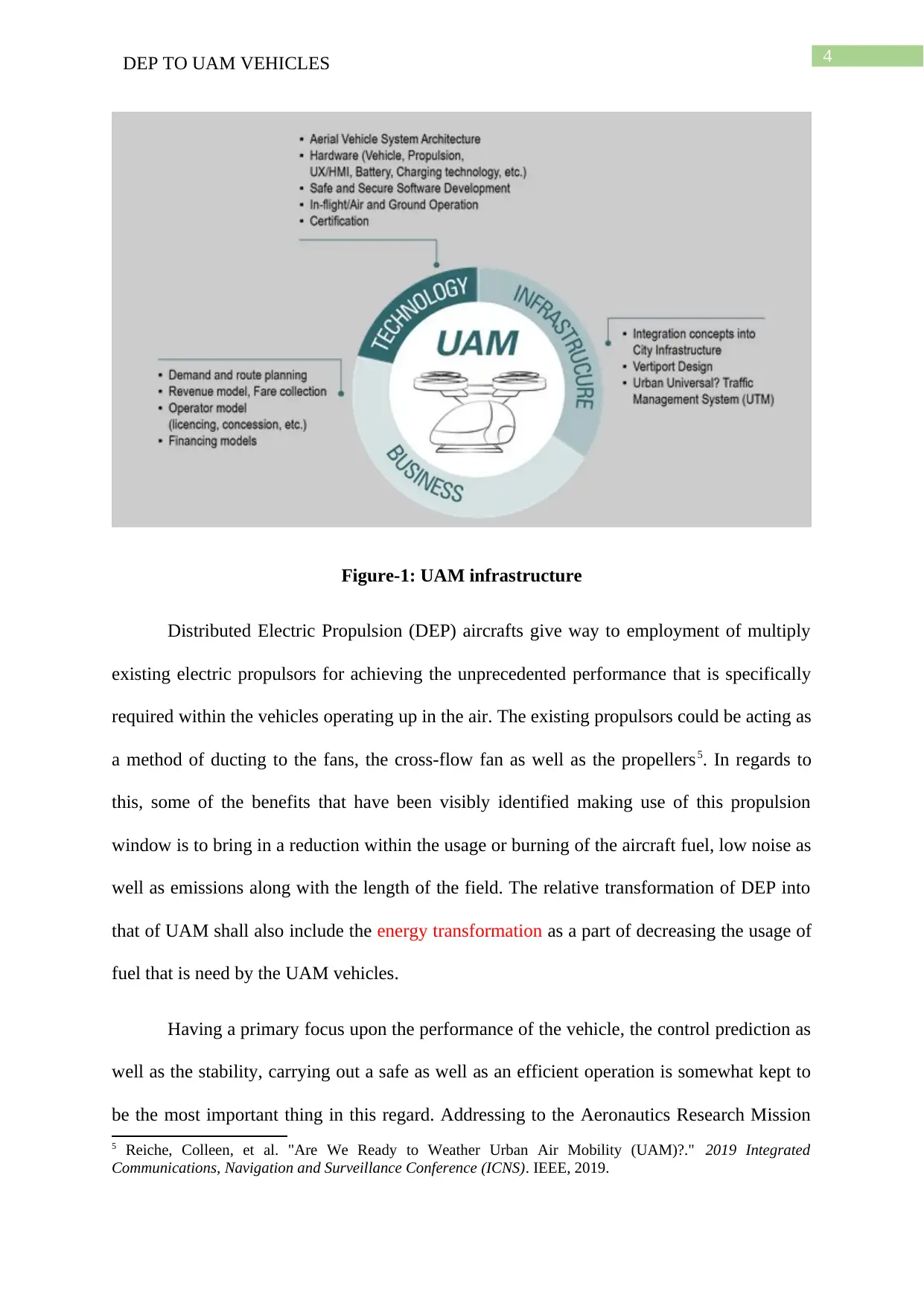
4DEP TO UAM VEHICLES
Figure-1: UAM infrastructure
Distributed Electric Propulsion (DEP) aircrafts give way to employment of multiply
existing electric propulsors for achieving the unprecedented performance that is specifically
required within the vehicles operating up in the air. The existing propulsors could be acting as
a method of ducting to the fans, the cross-flow fan as well as the propellers5. In regards to
this, some of the benefits that have been visibly identified making use of this propulsion
window is to bring in a reduction within the usage or burning of the aircraft fuel, low noise as
well as emissions along with the length of the field. The relative transformation of DEP into
that of UAM shall also include the energy transformation as a part of decreasing the usage of
fuel that is need by the UAM vehicles.
Having a primary focus upon the performance of the vehicle, the control prediction as
well as the stability, carrying out a safe as well as an efficient operation is somewhat kept to
be the most important thing in this regard. Addressing to the Aeronautics Research Mission
5 Reiche, Colleen, et al. "Are We Ready to Weather Urban Air Mobility (UAM)?." 2019 Integrated
Communications, Navigation and Surveillance Conference (ICNS). IEEE, 2019.
Figure-1: UAM infrastructure
Distributed Electric Propulsion (DEP) aircrafts give way to employment of multiply
existing electric propulsors for achieving the unprecedented performance that is specifically
required within the vehicles operating up in the air. The existing propulsors could be acting as
a method of ducting to the fans, the cross-flow fan as well as the propellers5. In regards to
this, some of the benefits that have been visibly identified making use of this propulsion
window is to bring in a reduction within the usage or burning of the aircraft fuel, low noise as
well as emissions along with the length of the field. The relative transformation of DEP into
that of UAM shall also include the energy transformation as a part of decreasing the usage of
fuel that is need by the UAM vehicles.
Having a primary focus upon the performance of the vehicle, the control prediction as
well as the stability, carrying out a safe as well as an efficient operation is somewhat kept to
be the most important thing in this regard. Addressing to the Aeronautics Research Mission
5 Reiche, Colleen, et al. "Are We Ready to Weather Urban Air Mobility (UAM)?." 2019 Integrated
Communications, Navigation and Surveillance Conference (ICNS). IEEE, 2019.
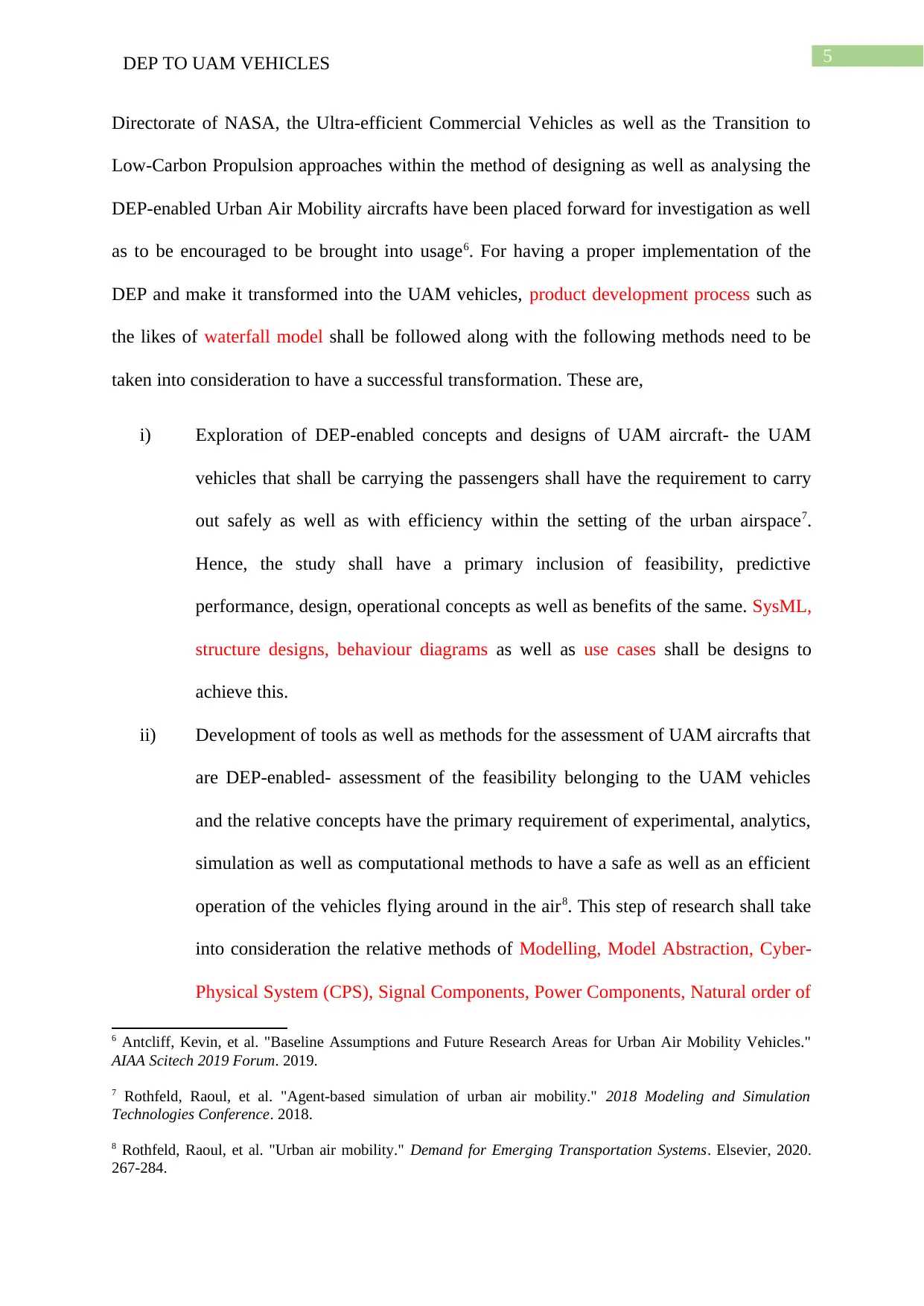
5DEP TO UAM VEHICLES
Directorate of NASA, the Ultra-efficient Commercial Vehicles as well as the Transition to
Low-Carbon Propulsion approaches within the method of designing as well as analysing the
DEP-enabled Urban Air Mobility aircrafts have been placed forward for investigation as well
as to be encouraged to be brought into usage6. For having a proper implementation of the
DEP and make it transformed into the UAM vehicles, product development process such as
the likes of waterfall model shall be followed along with the following methods need to be
taken into consideration to have a successful transformation. These are,
i) Exploration of DEP-enabled concepts and designs of UAM aircraft- the UAM
vehicles that shall be carrying the passengers shall have the requirement to carry
out safely as well as with efficiency within the setting of the urban airspace7.
Hence, the study shall have a primary inclusion of feasibility, predictive
performance, design, operational concepts as well as benefits of the same. SysML,
structure designs, behaviour diagrams as well as use cases shall be designs to
achieve this.
ii) Development of tools as well as methods for the assessment of UAM aircrafts that
are DEP-enabled- assessment of the feasibility belonging to the UAM vehicles
and the relative concepts have the primary requirement of experimental, analytics,
simulation as well as computational methods to have a safe as well as an efficient
operation of the vehicles flying around in the air8. This step of research shall take
into consideration the relative methods of Modelling, Model Abstraction, Cyber-
Physical System (CPS), Signal Components, Power Components, Natural order of
6 Antcliff, Kevin, et al. "Baseline Assumptions and Future Research Areas for Urban Air Mobility Vehicles."
AIAA Scitech 2019 Forum. 2019.
7 Rothfeld, Raoul, et al. "Agent-based simulation of urban air mobility." 2018 Modeling and Simulation
Technologies Conference. 2018.
8 Rothfeld, Raoul, et al. "Urban air mobility." Demand for Emerging Transportation Systems. Elsevier, 2020.
267-284.
Directorate of NASA, the Ultra-efficient Commercial Vehicles as well as the Transition to
Low-Carbon Propulsion approaches within the method of designing as well as analysing the
DEP-enabled Urban Air Mobility aircrafts have been placed forward for investigation as well
as to be encouraged to be brought into usage6. For having a proper implementation of the
DEP and make it transformed into the UAM vehicles, product development process such as
the likes of waterfall model shall be followed along with the following methods need to be
taken into consideration to have a successful transformation. These are,
i) Exploration of DEP-enabled concepts and designs of UAM aircraft- the UAM
vehicles that shall be carrying the passengers shall have the requirement to carry
out safely as well as with efficiency within the setting of the urban airspace7.
Hence, the study shall have a primary inclusion of feasibility, predictive
performance, design, operational concepts as well as benefits of the same. SysML,
structure designs, behaviour diagrams as well as use cases shall be designs to
achieve this.
ii) Development of tools as well as methods for the assessment of UAM aircrafts that
are DEP-enabled- assessment of the feasibility belonging to the UAM vehicles
and the relative concepts have the primary requirement of experimental, analytics,
simulation as well as computational methods to have a safe as well as an efficient
operation of the vehicles flying around in the air8. This step of research shall take
into consideration the relative methods of Modelling, Model Abstraction, Cyber-
Physical System (CPS), Signal Components, Power Components, Natural order of
6 Antcliff, Kevin, et al. "Baseline Assumptions and Future Research Areas for Urban Air Mobility Vehicles."
AIAA Scitech 2019 Forum. 2019.
7 Rothfeld, Raoul, et al. "Agent-based simulation of urban air mobility." 2018 Modeling and Simulation
Technologies Conference. 2018.
8 Rothfeld, Raoul, et al. "Urban air mobility." Demand for Emerging Transportation Systems. Elsevier, 2020.
267-284.
⊘ This is a preview!⊘
Do you want full access?
Subscribe today to unlock all pages.

Trusted by 1+ million students worldwide
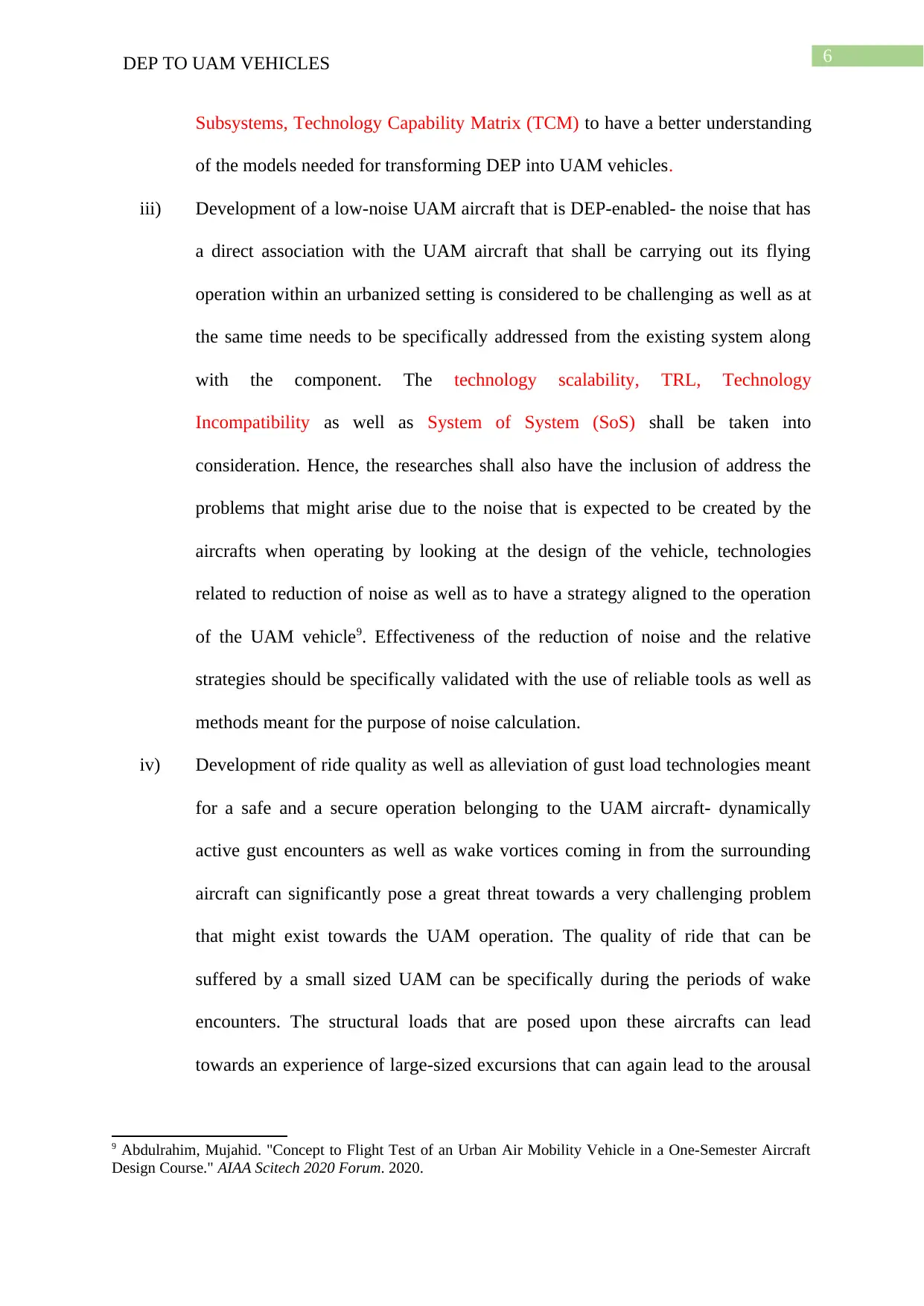
6DEP TO UAM VEHICLES
Subsystems, Technology Capability Matrix (TCM) to have a better understanding
of the models needed for transforming DEP into UAM vehicles.
iii) Development of a low-noise UAM aircraft that is DEP-enabled- the noise that has
a direct association with the UAM aircraft that shall be carrying out its flying
operation within an urbanized setting is considered to be challenging as well as at
the same time needs to be specifically addressed from the existing system along
with the component. The technology scalability, TRL, Technology
Incompatibility as well as System of System (SoS) shall be taken into
consideration. Hence, the researches shall also have the inclusion of address the
problems that might arise due to the noise that is expected to be created by the
aircrafts when operating by looking at the design of the vehicle, technologies
related to reduction of noise as well as to have a strategy aligned to the operation
of the UAM vehicle9. Effectiveness of the reduction of noise and the relative
strategies should be specifically validated with the use of reliable tools as well as
methods meant for the purpose of noise calculation.
iv) Development of ride quality as well as alleviation of gust load technologies meant
for a safe and a secure operation belonging to the UAM aircraft- dynamically
active gust encounters as well as wake vortices coming in from the surrounding
aircraft can significantly pose a great threat towards a very challenging problem
that might exist towards the UAM operation. The quality of ride that can be
suffered by a small sized UAM can be specifically during the periods of wake
encounters. The structural loads that are posed upon these aircrafts can lead
towards an experience of large-sized excursions that can again lead to the arousal
9 Abdulrahim, Mujahid. "Concept to Flight Test of an Urban Air Mobility Vehicle in a One-Semester Aircraft
Design Course." AIAA Scitech 2020 Forum. 2020.
Subsystems, Technology Capability Matrix (TCM) to have a better understanding
of the models needed for transforming DEP into UAM vehicles.
iii) Development of a low-noise UAM aircraft that is DEP-enabled- the noise that has
a direct association with the UAM aircraft that shall be carrying out its flying
operation within an urbanized setting is considered to be challenging as well as at
the same time needs to be specifically addressed from the existing system along
with the component. The technology scalability, TRL, Technology
Incompatibility as well as System of System (SoS) shall be taken into
consideration. Hence, the researches shall also have the inclusion of address the
problems that might arise due to the noise that is expected to be created by the
aircrafts when operating by looking at the design of the vehicle, technologies
related to reduction of noise as well as to have a strategy aligned to the operation
of the UAM vehicle9. Effectiveness of the reduction of noise and the relative
strategies should be specifically validated with the use of reliable tools as well as
methods meant for the purpose of noise calculation.
iv) Development of ride quality as well as alleviation of gust load technologies meant
for a safe and a secure operation belonging to the UAM aircraft- dynamically
active gust encounters as well as wake vortices coming in from the surrounding
aircraft can significantly pose a great threat towards a very challenging problem
that might exist towards the UAM operation. The quality of ride that can be
suffered by a small sized UAM can be specifically during the periods of wake
encounters. The structural loads that are posed upon these aircrafts can lead
towards an experience of large-sized excursions that can again lead to the arousal
9 Abdulrahim, Mujahid. "Concept to Flight Test of an Urban Air Mobility Vehicle in a One-Semester Aircraft
Design Course." AIAA Scitech 2020 Forum. 2020.
Paraphrase This Document
Need a fresh take? Get an instant paraphrase of this document with our AI Paraphraser
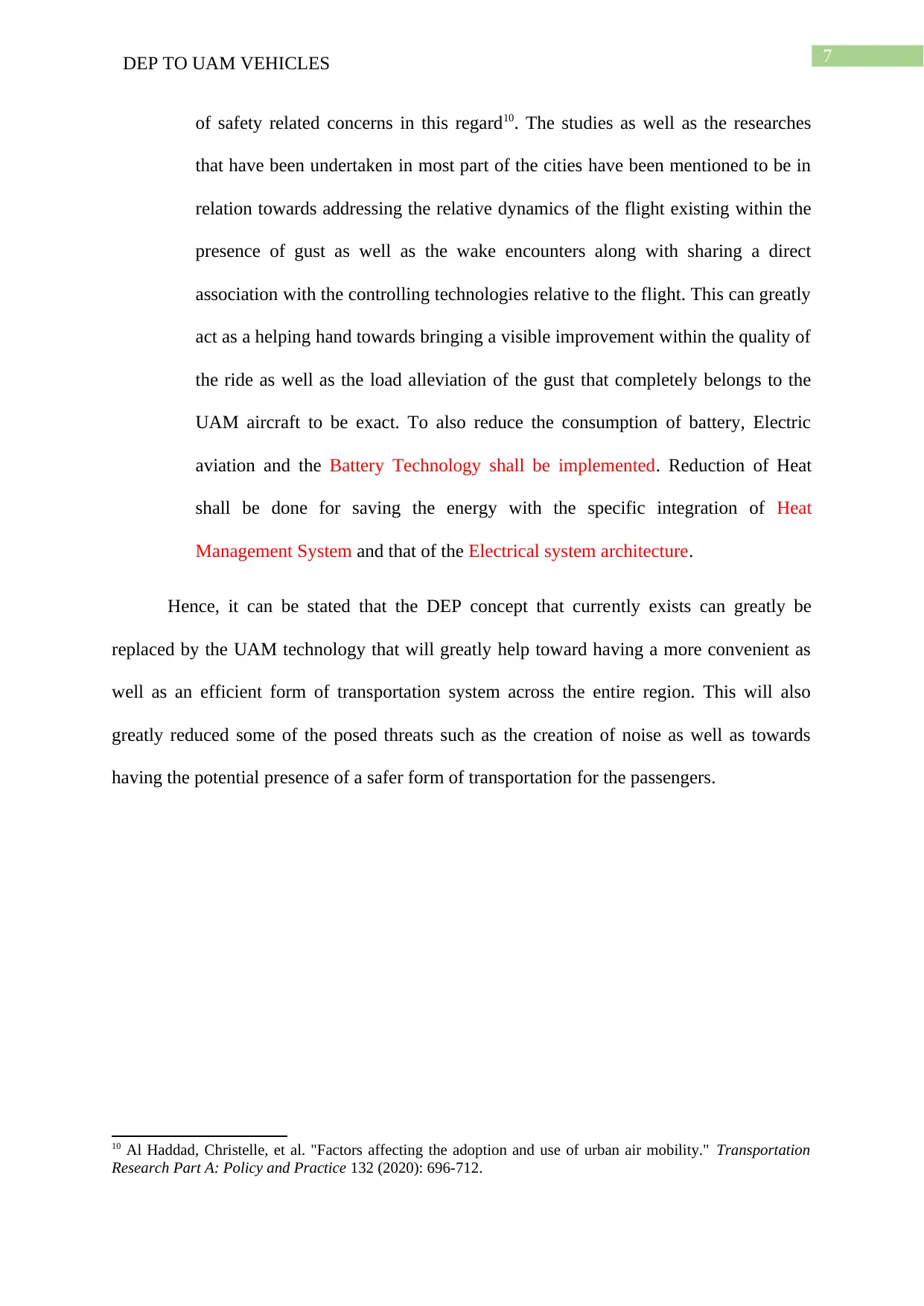
7DEP TO UAM VEHICLES
of safety related concerns in this regard10. The studies as well as the researches
that have been undertaken in most part of the cities have been mentioned to be in
relation towards addressing the relative dynamics of the flight existing within the
presence of gust as well as the wake encounters along with sharing a direct
association with the controlling technologies relative to the flight. This can greatly
act as a helping hand towards bringing a visible improvement within the quality of
the ride as well as the load alleviation of the gust that completely belongs to the
UAM aircraft to be exact. To also reduce the consumption of battery, Electric
aviation and the Battery Technology shall be implemented. Reduction of Heat
shall be done for saving the energy with the specific integration of Heat
Management System and that of the Electrical system architecture.
Hence, it can be stated that the DEP concept that currently exists can greatly be
replaced by the UAM technology that will greatly help toward having a more convenient as
well as an efficient form of transportation system across the entire region. This will also
greatly reduced some of the posed threats such as the creation of noise as well as towards
having the potential presence of a safer form of transportation for the passengers.
10 Al Haddad, Christelle, et al. "Factors affecting the adoption and use of urban air mobility." Transportation
Research Part A: Policy and Practice 132 (2020): 696-712.
of safety related concerns in this regard10. The studies as well as the researches
that have been undertaken in most part of the cities have been mentioned to be in
relation towards addressing the relative dynamics of the flight existing within the
presence of gust as well as the wake encounters along with sharing a direct
association with the controlling technologies relative to the flight. This can greatly
act as a helping hand towards bringing a visible improvement within the quality of
the ride as well as the load alleviation of the gust that completely belongs to the
UAM aircraft to be exact. To also reduce the consumption of battery, Electric
aviation and the Battery Technology shall be implemented. Reduction of Heat
shall be done for saving the energy with the specific integration of Heat
Management System and that of the Electrical system architecture.
Hence, it can be stated that the DEP concept that currently exists can greatly be
replaced by the UAM technology that will greatly help toward having a more convenient as
well as an efficient form of transportation system across the entire region. This will also
greatly reduced some of the posed threats such as the creation of noise as well as towards
having the potential presence of a safer form of transportation for the passengers.
10 Al Haddad, Christelle, et al. "Factors affecting the adoption and use of urban air mobility." Transportation
Research Part A: Policy and Practice 132 (2020): 696-712.
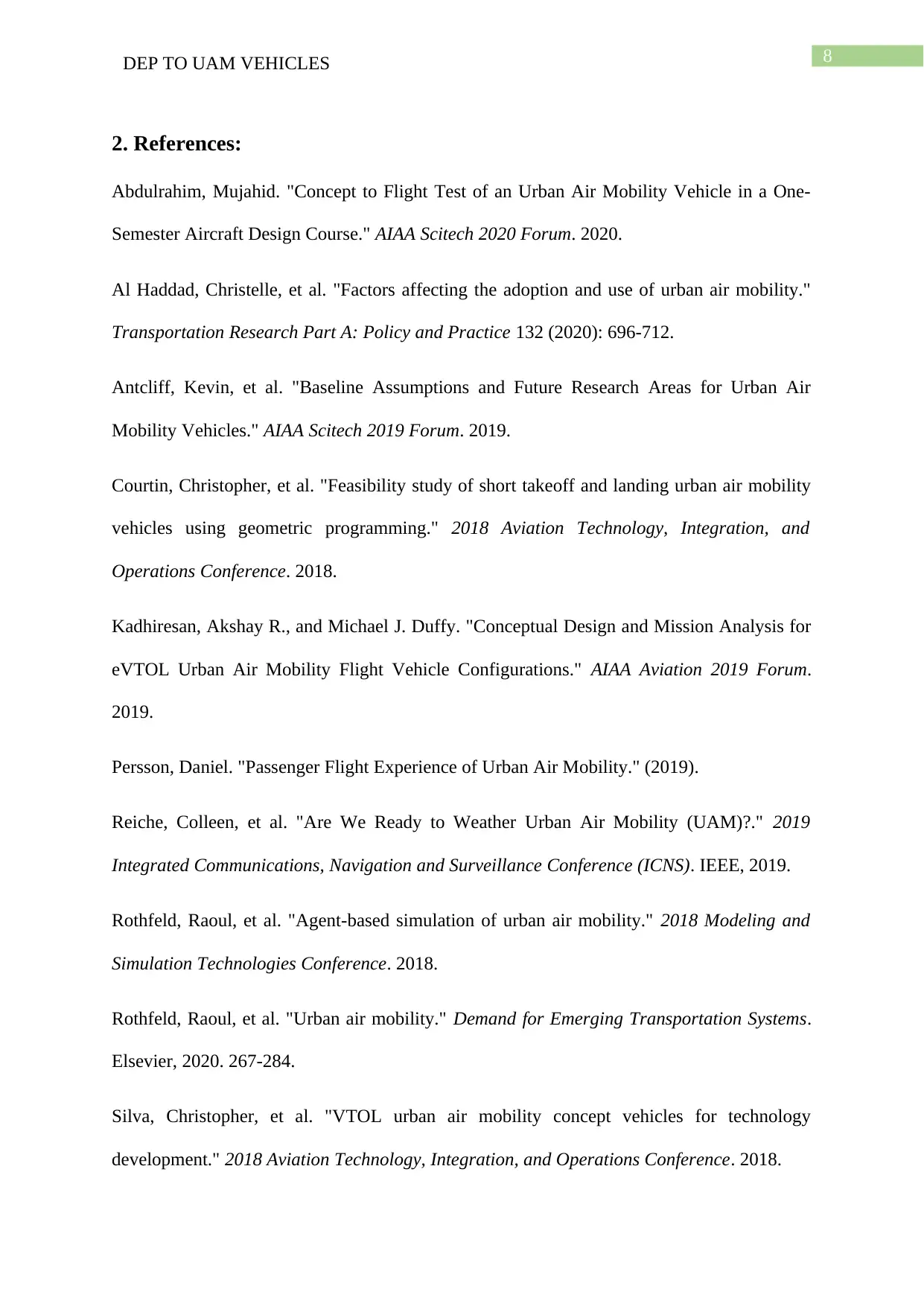
8DEP TO UAM VEHICLES
2. References:
Abdulrahim, Mujahid. "Concept to Flight Test of an Urban Air Mobility Vehicle in a One-
Semester Aircraft Design Course." AIAA Scitech 2020 Forum. 2020.
Al Haddad, Christelle, et al. "Factors affecting the adoption and use of urban air mobility."
Transportation Research Part A: Policy and Practice 132 (2020): 696-712.
Antcliff, Kevin, et al. "Baseline Assumptions and Future Research Areas for Urban Air
Mobility Vehicles." AIAA Scitech 2019 Forum. 2019.
Courtin, Christopher, et al. "Feasibility study of short takeoff and landing urban air mobility
vehicles using geometric programming." 2018 Aviation Technology, Integration, and
Operations Conference. 2018.
Kadhiresan, Akshay R., and Michael J. Duffy. "Conceptual Design and Mission Analysis for
eVTOL Urban Air Mobility Flight Vehicle Configurations." AIAA Aviation 2019 Forum.
2019.
Persson, Daniel. "Passenger Flight Experience of Urban Air Mobility." (2019).
Reiche, Colleen, et al. "Are We Ready to Weather Urban Air Mobility (UAM)?." 2019
Integrated Communications, Navigation and Surveillance Conference (ICNS). IEEE, 2019.
Rothfeld, Raoul, et al. "Agent-based simulation of urban air mobility." 2018 Modeling and
Simulation Technologies Conference. 2018.
Rothfeld, Raoul, et al. "Urban air mobility." Demand for Emerging Transportation Systems.
Elsevier, 2020. 267-284.
Silva, Christopher, et al. "VTOL urban air mobility concept vehicles for technology
development." 2018 Aviation Technology, Integration, and Operations Conference. 2018.
2. References:
Abdulrahim, Mujahid. "Concept to Flight Test of an Urban Air Mobility Vehicle in a One-
Semester Aircraft Design Course." AIAA Scitech 2020 Forum. 2020.
Al Haddad, Christelle, et al. "Factors affecting the adoption and use of urban air mobility."
Transportation Research Part A: Policy and Practice 132 (2020): 696-712.
Antcliff, Kevin, et al. "Baseline Assumptions and Future Research Areas for Urban Air
Mobility Vehicles." AIAA Scitech 2019 Forum. 2019.
Courtin, Christopher, et al. "Feasibility study of short takeoff and landing urban air mobility
vehicles using geometric programming." 2018 Aviation Technology, Integration, and
Operations Conference. 2018.
Kadhiresan, Akshay R., and Michael J. Duffy. "Conceptual Design and Mission Analysis for
eVTOL Urban Air Mobility Flight Vehicle Configurations." AIAA Aviation 2019 Forum.
2019.
Persson, Daniel. "Passenger Flight Experience of Urban Air Mobility." (2019).
Reiche, Colleen, et al. "Are We Ready to Weather Urban Air Mobility (UAM)?." 2019
Integrated Communications, Navigation and Surveillance Conference (ICNS). IEEE, 2019.
Rothfeld, Raoul, et al. "Agent-based simulation of urban air mobility." 2018 Modeling and
Simulation Technologies Conference. 2018.
Rothfeld, Raoul, et al. "Urban air mobility." Demand for Emerging Transportation Systems.
Elsevier, 2020. 267-284.
Silva, Christopher, et al. "VTOL urban air mobility concept vehicles for technology
development." 2018 Aviation Technology, Integration, and Operations Conference. 2018.
⊘ This is a preview!⊘
Do you want full access?
Subscribe today to unlock all pages.

Trusted by 1+ million students worldwide

9DEP TO UAM VEHICLES
1 out of 10
Your All-in-One AI-Powered Toolkit for Academic Success.
+13062052269
info@desklib.com
Available 24*7 on WhatsApp / Email
![[object Object]](/_next/static/media/star-bottom.7253800d.svg)
Unlock your academic potential
Copyright © 2020–2025 A2Z Services. All Rights Reserved. Developed and managed by ZUCOL.
